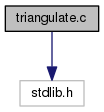|
QXRD
0.11.16
|
|
QXRD
0.11.16
|
#include <stdlib.h>
Go to the source code of this file.
Classes | |
| struct | ITRIANGLE |
| struct | IEDGE |
| struct | XYZ |
Macros | |
| #define | FALSE 0 |
| #define | TRUE 1 |
| #define | EPSILON 1e-10 |
Functions | |
| int | Triangulate (int nv, XYZ *pxyz, ITRIANGLE *v, int *ntri) |
| int | CircumCircle (double xp, double yp, double x1, double y1, double x2, double y2, double x3, double y3, double *xc, double *yc, double *rsqr) |
| #define EPSILON 1e-10 |
Definition at line 5 of file triangulate.c.
Referenced by CircumCircle().
| #define FALSE 0 |
Definition at line 3 of file triangulate.c.
Referenced by CircumCircle(), QxrdDetectorPerkinElmer::startDetector(), and Triangulate().
| #define TRUE 1 |
Definition at line 4 of file triangulate.c.
Referenced by CircumCircle(), and Triangulate().
| int CircumCircle | ( | double | xp, |
| double | yp, | ||
| double | x1, | ||
| double | y1, | ||
| double | x2, | ||
| double | y2, | ||
| double | x3, | ||
| double | y3, | ||
| double * | xc, | ||
| double * | yc, | ||
| double * | rsqr | ||
| ) |
Definition at line 227 of file triangulate.c.
References EPSILON, FALSE, and TRUE.
Referenced by Triangulate().

Definition at line 41 of file triangulate.c.
References CircumCircle(), FALSE, ITRIANGLE::p1, IEDGE::p1, ITRIANGLE::p2, IEDGE::p2, ITRIANGLE::p3, TRUE, XYZ::x, XYZ::y, and XYZ::z.
Referenced by QxrdCenterFinder::calculateCalibration().


 1.8.10
1.8.10